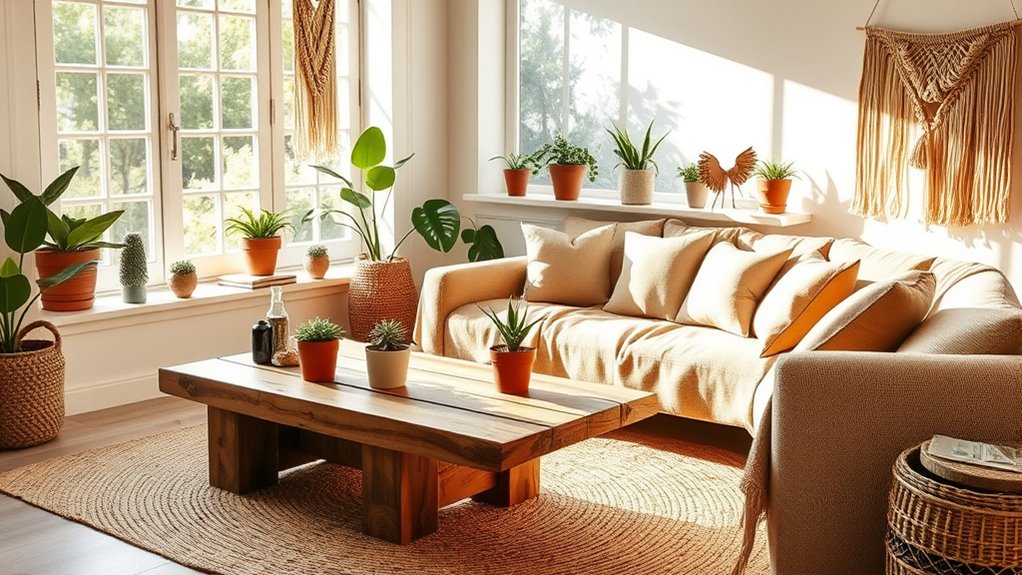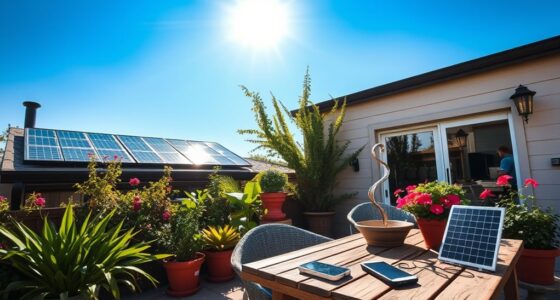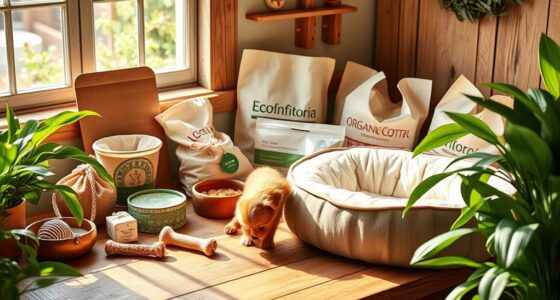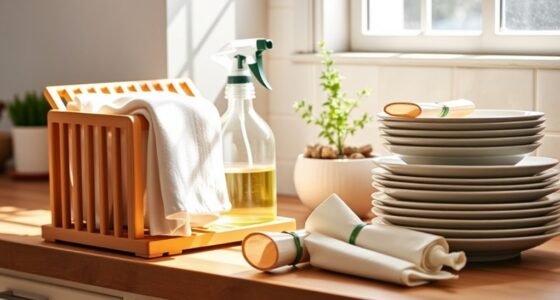To create an eco-friendly home décor, start by using sustainable materials like bamboo and reclaimed wood. Enhance your space with upcycled furnishings, and choose low VOC paints for healthier air quality. Incorporate indoor plants to naturally purify your surroundings and consider energy-efficient lighting options like LED bulbs to save energy. Look for brands that support sustainability and ethical sourcing. You'll discover how easy it is to create a beautiful, green living space with just a few thoughtful choices.
Key Takeaways
- Incorporate sustainable materials like bamboo, cork, and reclaimed wood for eco-friendly flooring and furniture options.
- Upcycle old items by transforming them into creative decor, such as turning vintage trunks into coffee tables.
- Choose eco-friendly paints with low or zero VOCs to improve indoor air quality while adding color to your space.
- Use energy-efficient lighting solutions like LED bulbs and solar-powered lights to reduce energy consumption and costs.
- Enhance your home with indoor plants that improve air quality and contribute to a healthier living environment.
Sustainable Materials for Home Décor
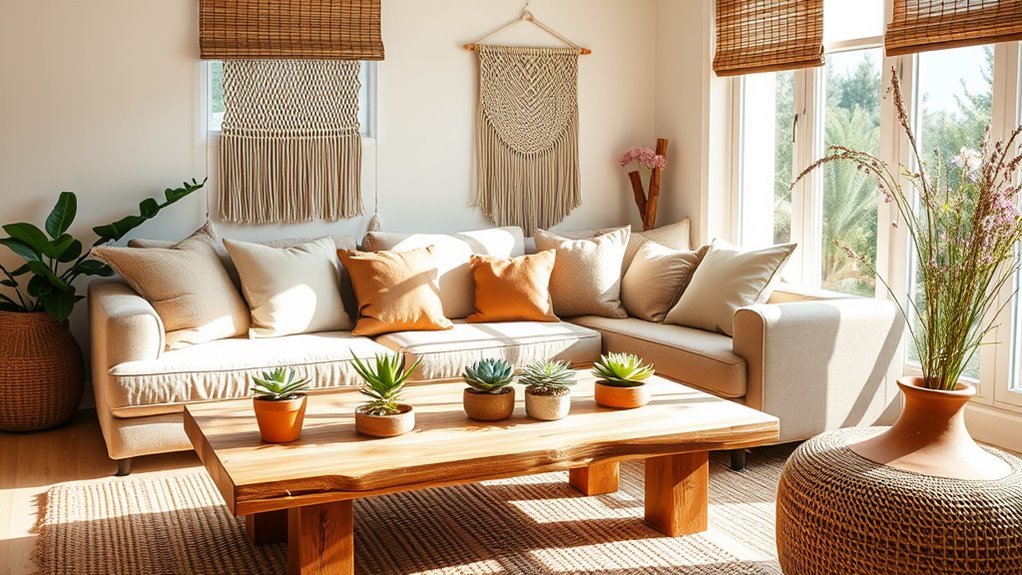
When you choose sustainable materials for your home décor, you're not just enhancing your living space; you're also making a positive impact on the environment.
Consider using bamboo, a fast-growing and renewable option for flooring and furniture. Cork is another great choice, offering durability and thermal insulation for flooring and wall tiles. Additionally, you might want to explore modern farmhouse decor trends, which emphasize the use of natural materials like wood and stone that not only add beauty but also sustainability. Incorporating eco-friendly options in your design can help reduce emissions and enhance the overall efficiency of your home.
For textiles, organic cotton, jute, and linen provide eco-friendly alternatives without harmful chemicals. Recycled glass items like vases reduce waste while adding style.
Don't forget about reclaimed wood, which helps lower deforestation. By incorporating these materials, you improve indoor air quality, support sustainable businesses, and create a home that reflects your eco-conscious values.
Additionally, ensure that your installation of any wood-burning stoves follows proper venting requirements to maintain a safe and energy-efficient environment.
Your choices today can lead to a greener tomorrow.
Upcycling and Repurposing Techniques
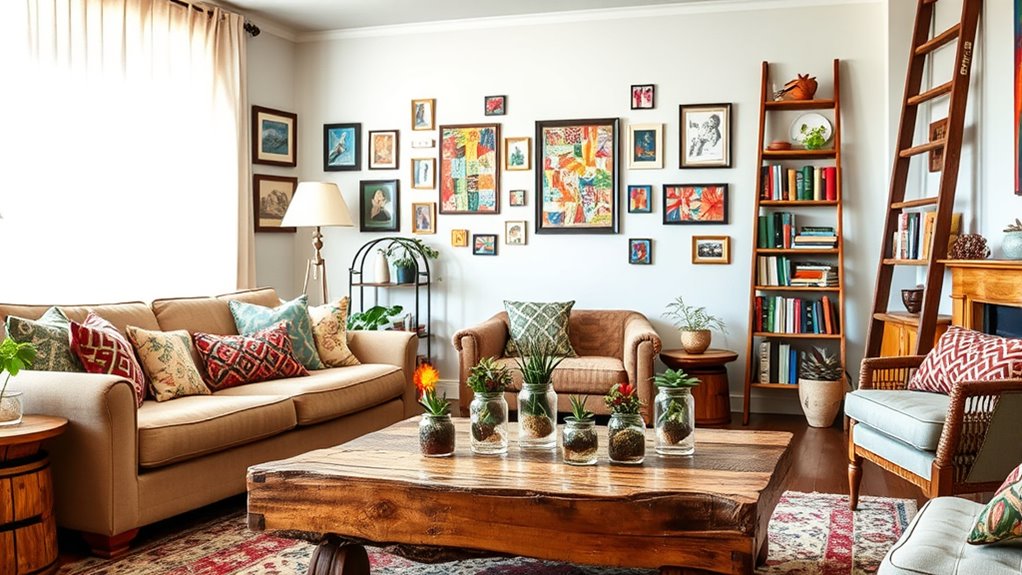
Incorporating sustainable materials is just one way to create an eco-friendly home; upcycling and repurposing techniques offer another exciting avenue to enhance your décor. You can transform old vases into unique centerpieces with a splash of paint or give old picture frames a modern touch for a stylish gallery wall. Reupholstering chairs and revamping dressers can breathe new life into your furniture, while vintage trunks make fantastic coffee tables. Additionally, understanding the importance of sustainable living practices can inspire more eco-friendly choices in your home projects. By embracing creative reuses, you can find innovative ways to give new purpose to items that might otherwise end up in a landfill.
Everyday items can also shine—consider turning mason jars into planters or using wine corks to craft a bulletin board. Additionally, creating your own greenhouse can be a fantastic way to extend your gardening season and grow your own food sustainably.
Choosing Eco-Friendly Paints

Choosing eco-friendly paints not only enhances the aesthetic of your home but also promotes a healthier living environment.
When selecting paint, look for options with low or zero VOCs to improve indoor air quality and reduce health risks. Opt for paints made from natural ingredients like plant oils and clay, which are both biodegradable and sustainable. Additionally, the trend towards using organic ingredients in various products reflects a growing consumer preference for sustainability. Environmental innovations in paint technology are paving the way for more sustainable options. Using eco-friendly paints can also contribute to improved skin health by minimizing harmful chemicals in your living space.
Support brands that use recycled or biodegradable packaging and practice responsible manufacturing. Check for eco-friendly certifications to ensure quality and transparency.
Eco-friendly paints offer vibrant colors from natural pigments, durability, and hypoallergenic properties, making them suitable for any space. Additionally, using wood stoves in your home can further enhance your eco-friendly initiatives by providing a sustainable heating option.
Enhancing Air Quality With Indoor Plants

Indoor plants can significantly enhance your home's air quality, creating a healthier living space while adding a touch of nature to your décor.
Research shows that plants like the Spider Plant and Snake Plant effectively remove pollutants such as formaldehyde and benzene. They absorb volatile organic compounds (VOCs) through their leaves and roots, purifying the air. Additionally, incorporating plants that have been shown to improve respiratory health can further enhance the benefits of your indoor garden. Many of these plants also require proper care to thrive and maximize their air-purifying capabilities. For example, larger plants typically need more water and proper drainage features to support their growth.
Plus, these plants increase humidity, helping to regulate room temperature and prevent dryness. Incorporating a variety of plants not only boosts air quality but also supports biodiversity by hosting beneficial microorganisms. Additionally, certain plants can provide health benefits that contribute to overall well-being.
Energy-Efficient Lighting Solutions
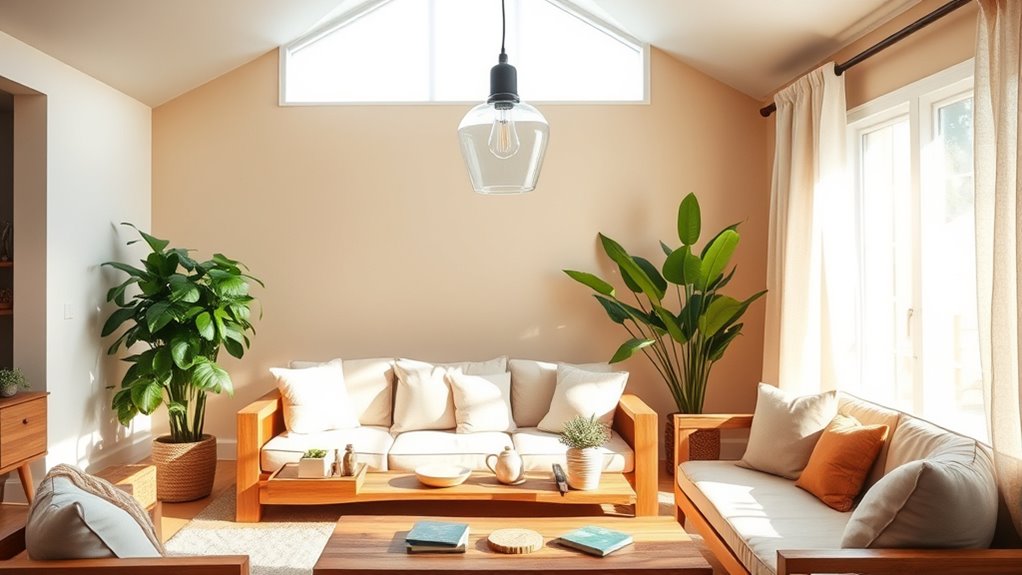
Creating a sustainable home goes beyond air quality; it also includes energy-efficient lighting solutions that can transform your space.
Consider switching to LED lighting, which uses up to 75% less energy and lasts 25 times longer than traditional bulbs. Regular cleaning of air purifiers can enhance their performance, contributing to a healthier indoor environment. CFL bulbs are another great option, consuming about 70% less energy and lasting ten times longer. Additionally, energy-efficient systems significantly lower carbon emissions and can complement your lighting choices. Integrating smart lighting systems can further enhance energy savings and convenience in your home.
For outdoor areas, solar-powered lighting harnesses renewable energy, making it eco-friendly and cost-effective. Smart lighting systems allow you to control your lights remotely and optimize energy usage, while features like motion sensors ensure lights only turn on when needed. Additionally, improving indoor air quality with air purifiers can complement your energy-saving efforts by creating a healthier environment.
Supporting Eco-Friendly Brands
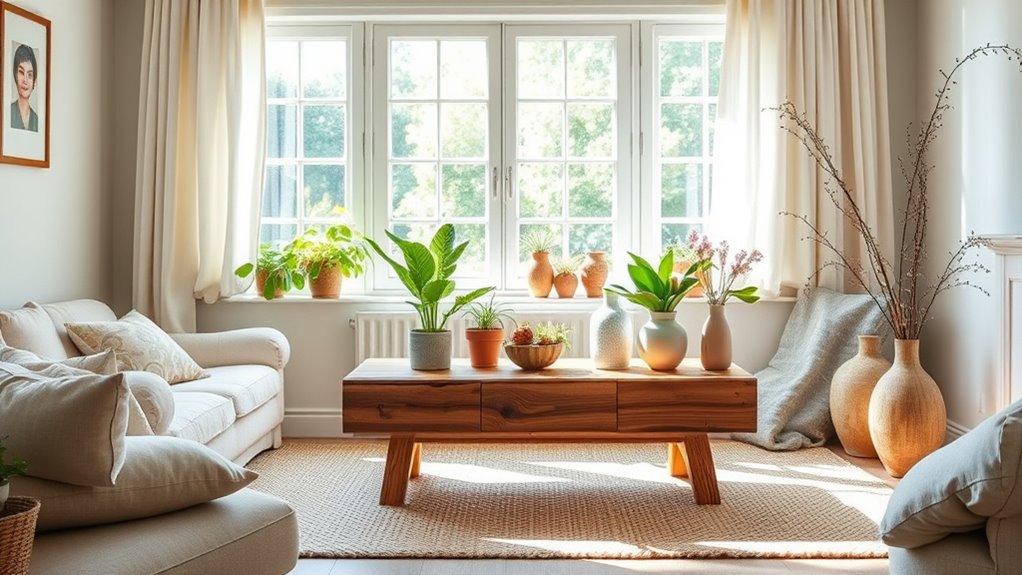
When you support eco-friendly brands, you're not just making a purchase; you're investing in a sustainable future. Brands like LIKHÂ use natural materials such as coconut coir and rattan wood, while The Citizenry and Ten Thousand Villages prioritize fair trade practices, ensuring artisans receive fair wages and safe working conditions. Additionally, many eco-friendly brands are committed to using renewable energy sources in their production processes, further promoting sustainability. In a similar vein, the integration of AI tools can enhance efficiency in these brands' operations, allowing them to scale sustainably.
By choosing to shop consciously, you can contribute to a sustainable economy, which benefits both the environment and communities. Look for brands with sustainable certifications like FSC and GOTS to guarantee responsible sourcing. Companies like Sabai incorporate recycled materials, turning waste into beautiful decor. By choosing eco-friendly brands, you're also supporting local artisans and creating economic opportunities in communities worldwide. Additionally, these brands often focus on enhancing the visual appeal, contributing positively to the overall ambiance of your home.
Creating a Green Living Space
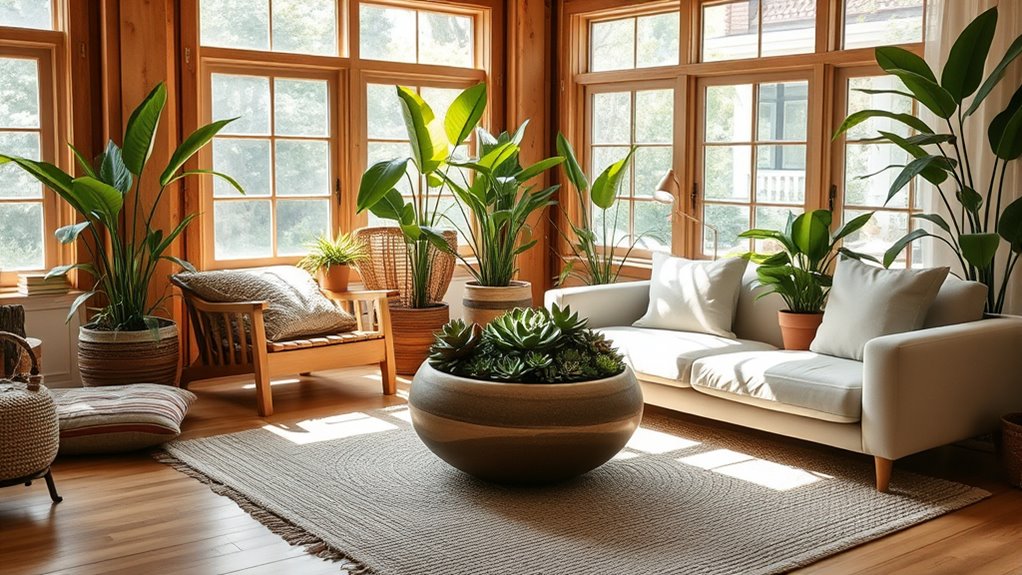
To transform your home into a green living space, start by selecting sustainable materials that not only look good but also minimize your environmental impact.
Choose natural textiles like organic cotton or hemp for your bedding and upholstery. Opt for FSC-certified wood when buying furniture to ensure it's sustainably sourced. Incorporate reclaimed materials to create unique decor, and add recycled metals for extra eco-friendliness.
Select organic textiles, FSC-certified wood, and reclaimed materials for a stylish and eco-friendly home.
Get creative by upcycling old furniture or repurposing thrift store finds. Use glass jars or crates for DIY decor and transform old bottles into stylish lighting.
Enhance energy efficiency with solar lights and LED bulbs, and maximize natural light to cut down on artificial lighting. Additionally, consider using high-quality equipment to create a more sustainable audio environment, as investing in durable tools can reduce waste over time. Small changes can make a big difference!
Frequently Asked Questions
How Can I Start My Eco-Friendly Home Décor Journey?
Starting your eco-friendly home décor journey is easier than you think!
Begin by assessing your current items and identifying what can be repurposed or donated.
Next, explore local shops that offer sustainable materials or furniture. Opt for items made from recycled or natural fibers, and don't forget to check labels for eco-friendly certifications.
Finally, make a plan to gradually replace non-sustainable items, creating a healthier space for you and the planet.
What Are the Costs Associated With Eco-Friendly Materials?
When you explore eco-friendly materials, you'll find a range of costs. Bamboo is usually affordable, while reclaimed wood varies based on quality.
Natural fibers like organic cotton can be pricier, but they're durable. Recycled materials often save you money since they reduce waste.
For textiles, organic options tend to be more expensive, but jute and sisal are budget-friendly.
Are There Any Grants for Sustainable Home Improvements?
Did you know that homeowners can save up to $3,450 in tax credits through the Inflation Reduction Act for energy-efficient upgrades?
Yes, there are several grants available for sustainable home improvements. You can explore options like government grants, utility company rebates, and the Weatherization Assistance Program.
Just make sure you meet the eligibility criteria, submit the required paperwork, and work with authorized contractors to maximize your benefits.
Don't miss out on these opportunities!
How Do I Dispose of Non-Eco-Friendly Décor Responsibly?
To dispose of non-eco-friendly décor responsibly, start by checking if you can donate items in good condition to local charities or thrift stores.
For materials like glass and metal, look into your community's recycling programs.
Don't forget specialized recycling for electronics and batteries—these need special handling.
You can also research sustainable disposal services that repurpose materials, ensuring they're not just thrown away but transformed into something useful instead.
Can I Mix Eco-Friendly and Traditional Décor Styles?
Absolutely, you can mix eco-friendly and traditional décor styles!
It's all about balance. Start by incorporating sustainable materials like reclaimed wood or organic fabrics alongside your favorite vintage pieces. This blend adds character while keeping your space stylish.
You might also consider using eco-friendly paint on traditional furniture to refresh its look.
Just remember, the key is to create harmony between the two styles, so your home feels cohesive and inviting.
Conclusion
By embracing these eco-friendly home décor ideas, you're not just beautifying your space; you're nurturing the planet. Each small change you make—whether it's choosing sustainable materials or adding a splash of greenery—creates a ripple effect that can inspire others. So, why not transform your home into a sanctuary of sustainability? With every thoughtful choice, you're planting the seeds for a brighter, greener future. Let your home reflect your commitment to a healthier world!
